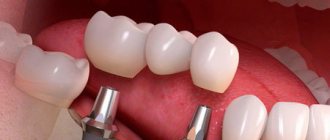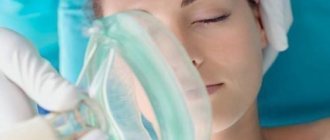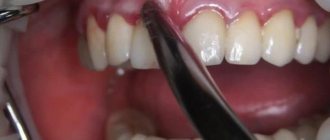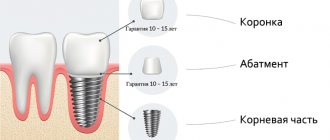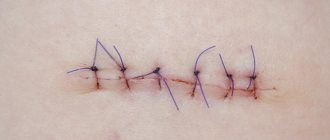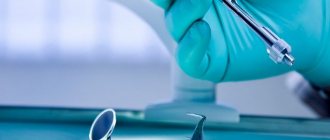Stages of implant installation
- Preparatory stage: treatment of carious teeth, gums, testing, diagnostic procedures.
- Surgical stage: an artificial root (Impro implant) is installed in the gum and the gum is sutured.
- The engraftment stage of the artificial root (lasts about six months)
- Stage of installation of the gum former.
- Abutment installation stage (link between root and crown)
- Stage of installation of the crown part of the tooth.
Dentists practice simultaneous implantation. The main advantage of this procedure is that the implant is installed without a healing period.
The process of implanting an artificial tooth violates the integrity of the gingival tissues of the oral cavity. Healing of the gums after dental implantation requires careful treatment and hygiene.
Cost of gum augmentation with implantation
Flap surgery is a mandatory stage in implantology. Gingivoplasty on one tooth is called localized, on several - generalized. It restores physiologically correct contours, ensuring stability of the tissues around the pin, preventing displacement. If necessary, the surgeon uses a periodontal flap to cover exposed roots taken from the hard palate or jaw and correct the shape of the gums.
Each case of plastic surgery of soft gum tissue is unique and the final price is calculated by the dentist at the first examination. The cost of gum augmentation with implantation depends on a number of factors:
- carrying out additional diagnostic and therapeutic measures;
- type of gingivoplasty;
- surgeon qualifications.
Make an appointment
Recovery period
Healing after dental implantation will be quick if all instructions are followed. After surgery, you may experience: numbness, swelling and fever. On day 5, the effects of surgery disappear. Healing after dental implantation of soft tissues occurs individually for everyone. On average, complete healing of injured areas is observed in the fourth week after surgery.
The healing process of the jawbone is longer. Complete healing occurs 5-6 months after surgery. There are cases where complete recovery occurs within a couple of months.
How to care for your gums after implantation?
The first thing to remember is: do not eat or drink anything during the first few hours after surgery. Once the anesthesia wears off, the sensations will be far from pleasant - and, obviously, eating can turn into torture. Don't make things worse for yourself and be patient.
In terms of food dos and don'ts, for the first few weeks, avoid hard, sticky foods or anything that can crumble or get stuck between your teeth. Dishes with a high content of salt and sugar, as well as hot pepper, are undesirable.
Don't forget to eat foods high in calcium to promote healing. If you smoke, it is better to give up this habit during the rehabilitation process.
Also try not to be in hot rooms - baths, saunas - and do not go to the beach while the implant is taking root.
Care after implantation
In order for the recovery period to proceed without complications, injured gums should be treated with dental ointments and rinsing solutions. It is recommended to use antibiotics for 5-6 days to avoid infectious complications. Experts prescribe: Lincomycin, Siflox, Doxycycline, Flemoxin.
Twice a day it is necessary to treat the mouth with antiseptic solutions: fucorcin, chlorhexidine, miramistin. Depending on the complexity of the healing process, antiseptics are used in the form of solutions or sprays.
Daily rinsing with solutions of sea salt, soda, chamomile, sage, laurel, eucalyptus, relieves swelling and inflammation. Infusions of oak bark, propolis, calendula, peppermint, rosemary destroy bacteria, relieve pain and inflammation.
Gels Kamistad, Dentol, Dentinox N will help relieve pain and sensitivity at the site of gum injury. Ointments Cholisal, Levomekol, Solcoseryl will speed up the healing process, relieve inflammation and infection of wounds.
After installing the implant, you should use a soft-bristled toothbrush. For 2-3 weeks you should avoid food that can damage the implant.
Caring for gums and taking medications after surgery
To ensure that nothing interferes with healing and that this process occurs as quickly as possible, dentists recommend following some rules for postoperative oral care. Basically, these rules apply to meals.
- For the first few hours after surgery, you should not take any food at all, even soft or liquid. Drinking is allowed through a straw. But, as a rule, patients themselves do not want to lean too heavily on food - since anesthesia may still be felt, and immediately after the anesthesia stops working, quite natural painful sensations may appear that interfere with eating.
- In the first weeks after installation of the implant, it is recommended to refrain from hard, crumbly, and sticky foods - crackers, nuts (including those contained in sweets and chocolates), toffees, kozinaki, tough meat, etc.
- You should also refrain from foods and dishes with a high content of both salt and sugar - salt irritates the unhealed surfaces of the mucous membrane, and sugar promotes the growth of bacteria in the oral cavity and on the teeth.
- Hot spices, garlic, hot pepper, etc. are undesirable.
- Hot and very cold drinks are also temporarily prohibited.
- It is advisable to bite off and chew pieces of food with the healthy half of the jaw - on the side opposite to the operated one.
- The diet should contain calcium-containing foods and mineral salts - this is important, since the body literally grows a section of the jaw bone, and “building materials” are needed for this.
- In addition, it is highly not recommended to smoke (and not only tobacco products, but also hookahs, bongs and even vapes), since the unhealed mucous membrane is highly irritated due to hot smoke or steam.
- You should not be in hot rooms, sunbathe on the beach, or visit a bathhouse or sauna.
Typically, the dentist should recommend an antibiotic to the patient, as there is an increased risk of infection during the postoperative period. You should not select and take an antibiotic drug on your own, without consulting a doctor, since the dentist must take into account all the characteristics of a particular patient and recommend a medication for a specific case. But you shouldn’t refuse to take the prescribed antibiotic - after all, this is not only an “emergency” remedy in case of any complications, inflammation, etc.: antibiotics allow you to avoid complications in principle. This is a preventive measure necessary after oral surgery. But for daily rinsing, antiseptic solutions and wound-healing preparations are prescribed.
If the patient follows all the prescribed rules and regularly visits the VivaDent clinic for routine examinations, then the implantation will take place without unnecessary problems and complications!
Complications
It is necessary to understand that the procedure of implanting an artificial tooth is a serious intervention that carries certain risks. Healing after dental implantation can occur with complications.
Early complications that occur immediately after the procedure include:
- pain;
- swelling;
- bleeding;
- heat;
- divergence of surgical sutures.
Complications that arise some time after implantation include:
- implant rejection;
- inflammation of the implantation area (peri-implantitis).
Complications that arise, if you follow the doctor’s recommendations, go away on their own. You should immediately consult your doctor in the following cases:
- bleeding for more than 3 days;
- purulent discharge appeared;
- swelling does not subside 5-6 days after the intervention;
- body temperature does not subside within 3 days;
- increased pain.
The likelihood of implant rejection is high if infection or damage to the implant occurs. In this case, the procedure can be repeated after a few months.
How does healing occur and what are the normal consequences?
- In the first few days, the area undergoing surgery will be painful - you don’t have to endure this at all, just use painkillers that the doctor recommends. Also, your gums may be swollen, and you may have a fever - this is not surprising, and there is no need to be alarmed.
- During the first week, you may experience itching in your gums - this is completely normal.
- If you have had stitches, you should come in for checkups weekly—or as often as your doctor advises. After 3-4 weeks, the stitches should be removed.
- By the end of the month you should completely stop experiencing discomfort. If this does not happen, be sure to see a specialist.
Features of gum augmentation during implantation
The manipulation is performed by an implant surgeon under local anesthesia. The surgeon performs plastic surgery for gum augmentation during implantation in stages:
- The working area is treated with an antibacterial agent.
- Makes several multidirectional incisions on the palate, cutting out internal and external flaps.
- Ostrozhnoe peels off both fragments and performs curettage (cleaning out periodontal pockets), preventing tissue detachment. The essence of the procedure is to remove bacterial deposits and excision of hypertrophied soft tissue.
- The internal flap is placed in place, sutured to the mucous membrane or periosteum, covered with the external one and a bandage is applied.
The duration of the operation is 40-60 minutes. The stitches are removed after 10 days.
Why do they contact us?
Gum augmentation during implantation globally solves aesthetic problems, restores lost jaw functions, and prevents the development of pathological processes. We guarantee patients painless gum surgery and quick postoperative recovery. The professionalism of doctors and the quality of the dental technologies used are evidenced by the minimal percentage of implant rejections and smooth gingival contours. Make an appointment with our clinic today to correct gum defects.
How long does it take for gums to heal after tooth extraction - timing
How long it takes for the gums to heal after tooth extraction depends on many factors: the degree of trauma of the removal, whether sutures were applied, the possible addition of infectious inflammation of the socket, and the age of the patient. Healing of the hole after tooth extraction can be divided into partial and complete.
Partial epithelization of the wound occurs on average in 12 days (Fig. 5), but complete epithelization of the surface of the clot is observed in 20 to 25 days (Fig. 6). However, if inflammation of the socket occurs or after a complex tooth extraction, which is usually accompanied by major bone trauma, the healing time may increase by several days.
Reasons for slow healing –
- significant trauma to the bone and gums during removal (both due to the doctor’s indifference and as a result of sawing out the bone around the tooth with a drill during difficult removal),
- when a clot falls out of the socket (empty socket),
- development of alveolitis of the socket,
- the doctor left fragments or inactive fragments of bone tissue in the socket,
- if sharp bone fragments protrude through the mucous membrane,
- if the gum mucosa around the hole is very mobile, and the doctor did not apply stitches,
- antibiotics were not prescribed after a complex removal,
- patient's age.

